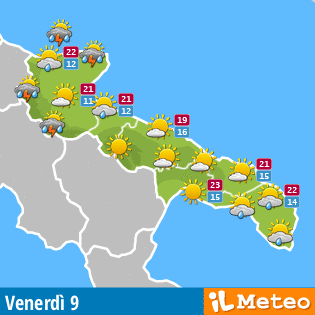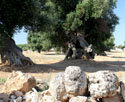Polignano a Mare
Info Polignano a Mare
-
Region:
Provincie:
Municipality:
CAP:
Area code:
Surface:
Population:
city hall:
-
Apulia
Bari
Polignano a Mare
70044
080
63,09 Kmq
17.621
Viale Delle Rimembranze 21
Polignano a Mare stands on a cliff falling sheer to the Adriatic sea
On the top of a cliff that falls sheer to the sea being 24 metres high in the highest point, stands the old town of Polignano, where the coast is characterized by erosive phenonema and inlets. It has Greek origins but some scholars assert that it was already peopled during the prehistoric age. Some evidences could be the settlement of Santa Barbara and the adjacent hypogeum Manfredi.
The old town centre appears compact and solid, defending the ancient urban agglomeration, which is divided from the modern town by a deep canyon ending up in the little beach said Cala Paura, natural fiord once used as port. The calcareous cliff shows wide caves at sealevel, shaped by the wave motion; the most famous cave is the so called Grotta Palazzese, which has belonged to a family of marquises, that has employed it to give parties since the 18th century; today it houses a famous restaurant. In the past it has been diocesan centre too, from 672 to 1818.
Within the suburb, characterized by white buildings on the cliff and narrow alleys, we can admire the sea from many terraces with a panoramic view, sheer to the sea. Next to the ancient clock tower, there is the church said dell’Assunta, that is the ancient Romanesque cathedral built in the 13th century; it shows a Basilical plan with three naves and a transept.
During the centuries, it has been renovated many times; it houses valuable works realized by the Renaissance sculptor Stefano da Putignano and a 15th – century polyptych of Venetian style by Bartolomeo Vivarini. In the 18th century the church was renewed according to the Baroque taste with the building of a monumental presbytery on two levels, with a superior chapel we reach through a monumental great staircase.
The city of Polignano is the birthplace of the contemporary artist Pino Pascali, to whom the municipal museum is dedicated, and of the great singer-songwriter Domenico Modugno, who is famous all over the world. At three km from the town, lies the marine administrative division of San Vito. Heart of San Vito is the medieval Benedictine abbey built, according to the tradition, after the miraculous landing of the martyr’s relics.













